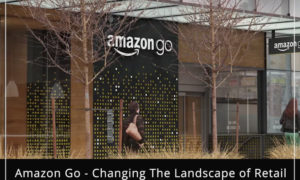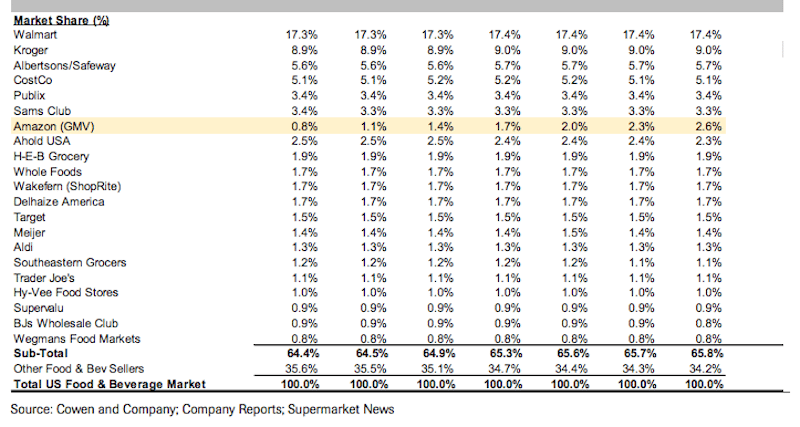Since yesterday, the news sections all across the world wide web, have been abuzz with Amazon’s latest business venture: Amazon Go.
While retailers across the world are trying to step into the world of eCommerce, the eCommerce giant has made new advances in its encroachment on the brick-and-mortar world, and that too with an extreme statement of style. Here’s an officially released glimpse of the look and feel of Amazon’s new grocery store. The video released online and produced by Amazon is easily going to be among the most watched futuristic retail videos around, with having scored 2 million views in less than 24 hours.
Amazon’s first physical grocery store comes with no cashiers or check out lines. It is a new kind of store featuring the world’s most advanced shopping technology. No lines, no checkout – just grab and go!
Located at 2131 7th Ave, Amazon Go is limited to a new 1,800 square feet of retail space and is only open to the company’s employees during the beta program. The store is expected to open to the public in early 2017.
Considering that there is almost no aspect of retail that Amazon has not revolutionized with technology, it is little surprise that the company is now trying to computerize the experience offered by the corner convenience store. The small grocery store in Seattle allows customers to pluck drinks, prepared meals and other items off shelves and walk out without having to wait in a checkout line. The Just Walk Out technology utilizes computer vision, sensor fusion and deep learning algorithms to provide this seamless shopping experience. This eliminates the usual bottleneck of cashiers and registers that typically stand between shoppers and the store exit.
In a time when retailers across the world are struggling to pick their fights across the battlegrounds of virtual and real, we find physical retailers increasingly turning to technology to streamline operations. Walmart, an Amazon rival that is revving up its e-commerce game, recently introduced its own mobile payments service in the U.S., as it strives to compete with online retailers by making it easier to check out.
In the given circumstances, perhaps what’s more striking is that Amazon is indeed doubling down on its brick-and-mortar strategy. From launching bookstores in November 2015, to pop-up stores this year, and now a grocery store, Amazon has been aggressively expanding its presence in the physical space.
As per the analysts with Cowen, the move shows how Amazon is now going after the the grocery business, which represents about 17 percent of total U.S. retail, or nearly $800 billion, and is an area dominated by Walmart with a 21% share in the grocery market. For Amazon – outside of the top 20 with just 0.8% share as of last year, and expected to be 7th largest by 2021 – it represents a huge source of potential revenue growth, plus another way to ensconce itself in people’s shopping habits. And, Amazon, in its infinite capitalistic wisdom, seemingly has found the way: Amazon Go.
On Monday Amazon shares closed up 2.6 percent, trading at $759.36 and widely outperforming the market with a plus of 19+ points.
- Source: Markets Insider
Interestingly, it was only 9 years ago when the Amazon CEO Jeff Bezos had shared his reservations against the idea of Amazon stepping into the realm of physical stores. In a shareholder letter published in 2007, Bezos wrote:
“The potential size of a network of physical stores is exciting. However: we don’t know how to do it with low capital and high returns; physical-world retailing is a cagey and ancient business that’s already well served; and we don’t have any ideas for how to build a physical world store experience that’s meaningfully differentiated for customers.”
It is almost after a decade that Amazon has come up with its answer to all those questions.
The company explains why it created Amazon Go:
Four years ago we asked ourselves: what if we could create a shopping experience with no lines and no checkout? Could we push the boundaries of computer vision and machine learning to create a store where customers could simply take what they want and go?
Our answer to those questions is Amazon Go and Just Walk Out Shopping.
Like the rest of the world, I am myself mesmerized by the scope of artificial intelligence taking over yet another aspect of our daily lives, however, what remains to be seen is how do the economies with increasing lack of human jobs respond to the Just Walk Out Technology offered by Amazon Go.
While we in Pakistan sit back and distantly watch in awe the miracles of innovation, it’d be a good note to end at by quoting words of Bezos in the latest Amazon annual report.
He writes:
I believe we are the best place in the world to fail (we have plenty of practice!), and failure and invention are inseparable twins. To invent you have to experiment, and if you know in advance that it’s going to work, it’s not an experiment. Most large organizations embrace the idea of invention, but are not willing to suffer the string of failed experiments necessary to get there. Outsized returns often come from betting against conventional wisdom, and conventional wisdom is usually right. Given a ten percent chance of a 100 times payoff, you should take that bet every time. But you’re still going to be wrong nine times out of ten. This long-tailed distribution of returns is why it’s important to be bold. Big winners pay for so many experiments.
The bold culture of innovation is where Amazon’s strength lies, and this is why it’s always leading the game of retail.
Featured image: Amazon




